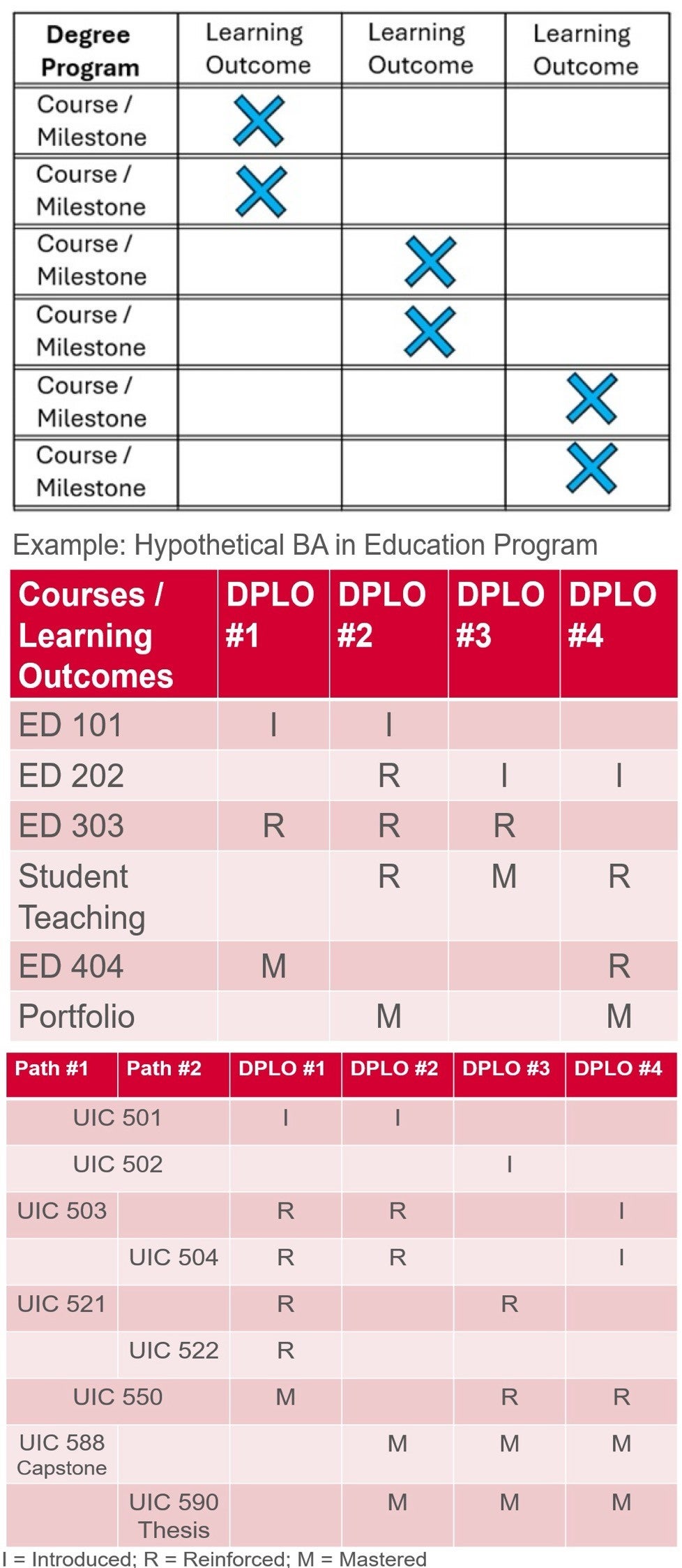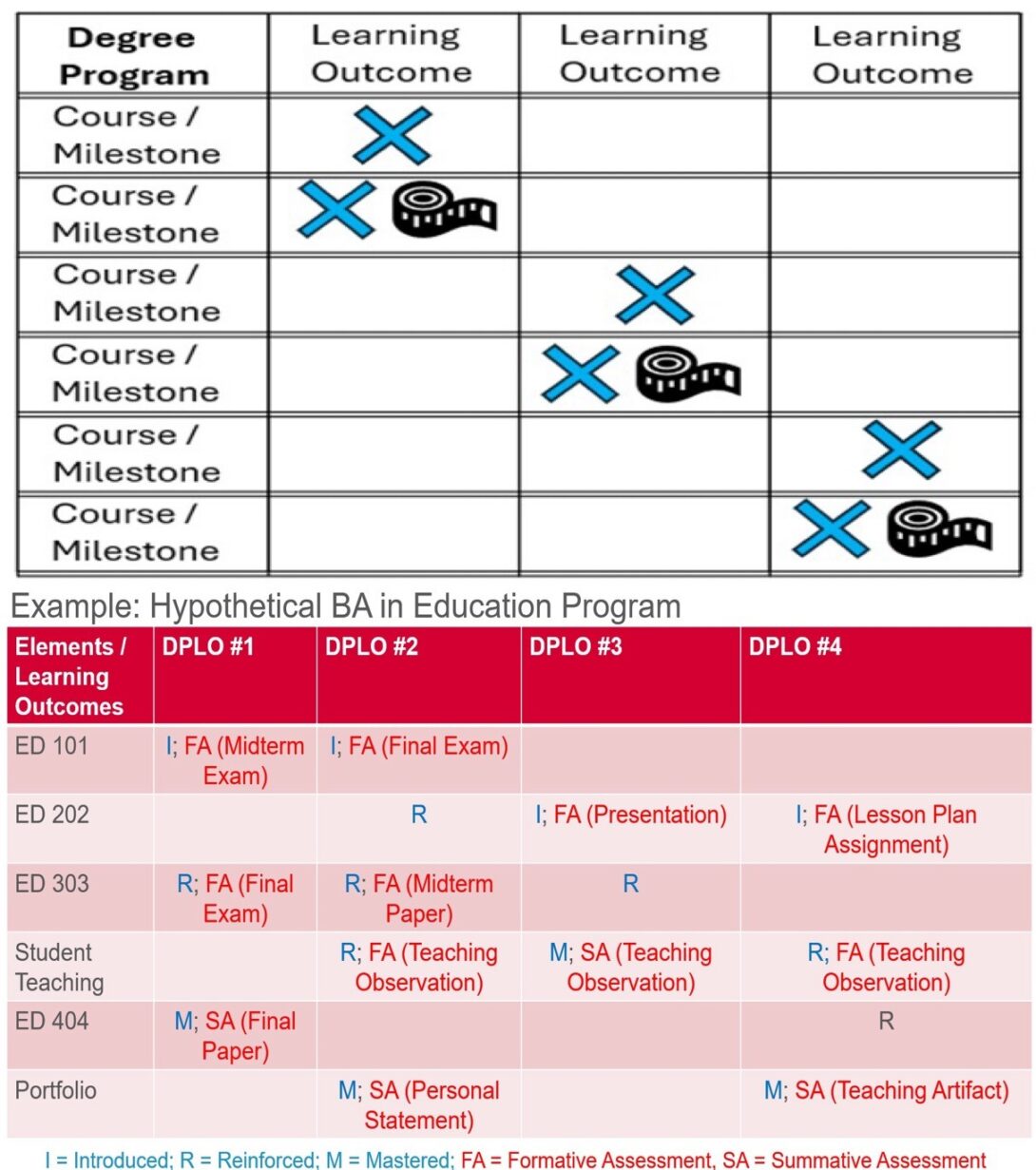Create Curriculum Maps
The process of curriculum mapping helps the program determine the relationship between different educational elements of a program. These educational elements include: purposefully structured and sequenced educational experiences (what is typically understood as the program's curriculum), the degree program learning outcomes, and the assessment methods used to assess student learning related to the learning outcomes.
Curriculum mapping has multiple benefits that include helping programs:
1. Clarify the values and priorities of the curriculum through its designed instructional alignment and intentional assessment practices,
2. Reveal gaps in educational design related to content, sequence, and learning assessment,
3. Consistently implement degree program learning outcome assessment,
4. Communicate educational expectations and why they are important (especially when shared with students), and
5. Produce evidence of sound curriculum design and learning assessment practice to satisfy institutional accreditation expectations.
There are three typical types of curriculum maps: curriculum instructional maps, curriculum assessment maps, and comprehensive curriculum maps. Click the drop-down tabs below to a) learn more about each type of curriculum map and access a blank curriculum map template, b) review questions to use with a curriculum map, and c) view additional resources to learn more about curriculum maps.
Curriculum Map Types
Curriculum Instructional Maps

Curriculum instructional maps are focused on the relationship between educational experiences relative to learning outcomes. These maps identify where the learning outcomes are addressed relative to each course and / or educational milestone (e.g., internship / practicum, proposal defense, dissertation defense) within the program. For programs that offer more than one pathway to degree completion, curriculum instructional maps also indicate which courses and / or educational milestones are necessary for each program completion pathway.
Curriculum instructional maps are particularly useful to programs when designing and revising curricular sequences to ensure all learning outcomes are adequately addressed.
Click here for a curriculum instructional map excel template for programs with a single pathway toward completion.
Click here for a curriculum instructional map template for programs with more than one pathway toward completion.
Curriculum Assessment Maps

Curriculum assessment maps are focused on how and where assessment methods are implemented within an educational experience relative to learning outcomes. These maps identify where the learning assessment should occur for each learning outcome with details about how and where learning data is generated. Curriculum assessment maps should at least include information for where summative assessment takes place for each learning outcome. However, curriculum assessment maps can also include information for where both formative and summative assessment occurs.
Curriculum assessment maps are particularly useful to programs when conducting degree program learning outcome assessment, and also help programs measure and compare the impact of curricular revisions over time.
Click here for a curriculum assessment map excel template for programs with a single pathway toward degree completion.
Click here for a curriculum assessment map excel template for programs with more than one pathway toward completion.
Comprehensive curriculum maps

Comprehensive curriculum maps illustrate the relationship between educational experiences relative to learning outcomes, as well as how and where assessment methods are implemented for each learning outcome. These maps combine the same information from both the curriculum instructional map and the curriculum assessment map.
Comprehensive curriculum maps are particularly useful to programs when designing and revising curricular sequences to ensure all learning outcomes are adequately addressed and assessed in meaningful ways to support curricular success.
Click here for a comprehensive curriculum map excel template for programs with a single pathway toward degree completion.
Click here for a comprehensive curriculum map excel template for programs with more than one pathway toward completion.
na
Once you have completed your curriculum mapping process and have your completed map, you can use the maps to ask and answer important questions to support your educational efforts. Here are two lists of useful questions you might use:
Curriculum Instructional Maps:
1. To what extent does each course / milestone contribute to a) the learning outcomes and b) the broader curriculum?
2. To what extent are the learning outcomes aligned with, and attainable based upon, the content and sequence of the curriculum?
3. To what extent are the curricular requirements and sequence optimal to support student success?
4. Does the curriculum (both the content and learning outcomes) best prepare students to excel post-graduation?
5. To what extent are students completing curricular requirements as anticipated / expected by the program?
6. Are courses / milestones appropriately positioned as required, strongly encouraged, or optional?
7. Are the learning outcomes sufficiently addressed within / across the curriculum?
8. What gaps exist between the learning outcomes and the curricular design?
Curriculum Assessment Maps:
1. Are the methods used to assess learning adequately aligned with the learning outcomes?
2. Are the learning outcomes actually assessed following the process outlined in the map?
3. Are there sufficient opportunities to provide feedback to students about their performance in order to improve by the time mastery is expected?
Comprehensive Curriculum Maps:
1. To what extent does each course / milestone contribute to a) the learning outcomes and b) the broader curriculum?
2. To what extent are the learning outcomes aligned with, and attainable based upon, the content and sequence of the curriculum?
3. To what extent are the curricular requirements and sequence optimal to support student success?
4. Does the curriculum (both the content and learning outcomes) best prepare students to excel post-graduation?
5. To what extent are students completing curricular requirements as anticipated / expected by the program?
6. Are courses / milestones appropriately positioned as required, strongly encouraged, or optional?
7. Are the learning outcomes sufficiently addressed within / across the curriculum?
8. What gaps exist between the learning outcomes and the curricular design?
9. Are the methods used to assess learning adequately aligned with the learning outcomes?
10. Are the learning outcomes actually assessed following the process outlined in the map?
11. Are there sufficient opportunities to provide feedback to students about their performance in order to improve by the time mastery is expected?
Additional Resources
If you wish to learn more about curriculum mapping, you might consider the following publications and websites that are used by our office:
- National Institute for Learning Outcomes Assessment. (2018, December). Mapping learning: A toolkit. Urbana, IL: University of Illinois and Indiana University, Author.
https://www.learningoutcomesassessment.org/wp-content/uploads/2019/02/MappingLearning
.pdf - Jankowski, N. A., & Baker, G.A. (2020, June). Mapping and assessing student learning in student affairs (Occasional Paper No. 45). University of Illinois and Indiana University, National Institute for Learning Outcomes Assessment. https://www.learningoutcomesassessment.org/wp-content/uploads/2020/07/OccasionalPaper
45.pdf - Jankowski, N. A., & Marshall, D. W. (2017). Degrees that matter: Moving higher education to a learning systems paradigm. Routledge.
- University of Hawai’i at Mānoa (2024, March 4). Curriculum Mapping / Curriculum Matrix. Assessment and Curriculum Support Center. https://manoa.hawaii.edu/assessment/resources/curriculum-mapping-curriculum-matrix/.
Additionally, you may watch an online training video on curriclum mapping that was created by our office which is availlable on our “online video trainings” page.